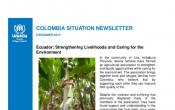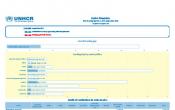Colombia
Operation: Colombia
Location
{"longitude":-73,"latitude":4,"zoom_level":0}
Latest update of camps and office locations 13 Jan 2016. By clicking on the icons on the map, additional information is displayed.
Key Figures
| 2015 end-year results | |
| 128 | communities at risk of displacement were supported by UNHCR |
| 134 | government partners benefited from technical assistance to strengthen their institutional capacity |
| 182 | refugees and asylum-seekers had access to legal assistance |
| 107 | asylum-seekers and refugees benefited from a cash-based initiative that provided legal assistance and short-term financial assistance |
| 6 | refugees were assisted with income generation support, vocational training and Spanish language courses |
| 2016 planning figures | |
| 17 | communities benefitted from the Transitional Solutions Initiative (TSI) pilot, which tested sustainable methodologies for IDP local integration, relocation and return. |
Latest Updates
People of Concern
15%
Increase in
2015
2015
| 2015 | 6,941,212 |
| 2014 | 6,044,552 |
| 2013 | 5,368,462 |

[["Refugees",226],["Asylum-seekers",115],["IDPs",6939067],["Returned refugees",1792],["Stateless",12]]
Loading ...
Budgets and Expenditure for Colombia
< Back
2015
{"categories":[2012,2013,2014,2015,2016],"budget":[29.39275787,29.63863097,30.54009716,31.64999552,31.43355071],"expenditure":[17.97013045,19.72971212,18.22635741,15.30149255,null]}
{"categories":[2012,2013,2014,2015,2016],"p1":[1.03953852,1.25005017,1.36255488,1.28923061,0.91189086],"p2":[null,null,null,null,null],"p3":[null,null,null,null,null],"p4":[28.35321935,28.3885808,29.17754228,30.36076491,30.52165985]}
{"categories":[2012,2013,2014,2015,2016],"p1":[0.88555543,0.85886962,0.71250308,0.65932352,null],"p2":[null,null,null,null,null],"p3":[null,null,null,null,null],"p4":[17.08457502,18.8708425,17.51385433,14.64216903,null]}
Loading ...
CHOOSE A YEAR
- 2014
- 2015
- 2016
Working environment
- As a major advance in the peace process ongoing since 2012, the president of Colombia and the head of the Revolutionary Armed Forces of Colombia (FARC) announced in September 2015 that an agreement had been reached in principle on transitional justice. The signature of a peace agreement is foreseen for 2016.
- Despite this progress, instances of violence are still frequent in different areas of the country, and forced displacement continues. While some of the structural causes of displacement have been tackled in recent years, others still need to be addressed, including systematic dispossession schemes and violence perpetrated by different armed actors.
Population trends
- The Government has recognized 7,860,385 persons as victims of armed conflict, nearly 14 per cent of the total population. Over 80 per cent of these were forcibly displaced people (6,646,395).
- In 2015, some 66 large-group displacement events were reported affecting 4,085 families in 36 municipalities. In total, over 156,600 people have so far been registered as newly displaced in 2015, although registration and verification continues. Internal displacement disproportionately affects indigenous people, Afro-Colombian and LGBTI communities.
- Children between 8 and 13 years old were at high risk of recruitment and exploitation by the FARC and post-demobilized groups, both in urban and rural areas.
- There was a total of 226 refugees, and 108 asylum-seekers were awaiting adjudication on behalf of the Government. Most of the refugees were from Cuba (27 per cent), Venezuela (17 per cent), Ethiopia (7 per cent), Nicaragua (6 per cent) and Somalia (5 per cent). 18 refugees were recognized during 2015.
Achievements and impact
To assist vulnerable groups, UNHCR developed several interventions in collaboration with partners. The Office namely:- Supported 128 communities at risk of displacement, including through the deployment of ombudspersons in isolated areas of 13 departments and through the implementation of 45 Practical Protection Projects (the majority community infrastructure) to ensure protection by presence and uphold humanitarian space;
- Implemented 45 mitigation measures to prevent forced recruitment and use of children and youth by illegal armed groups, including by strengthening safe protection environments (including schools) and access to education;
- Promoted the activation of local protection systems in isolated areas in coordination with national and local authorities;
- Provided technical assistance to strengthen the institutional capacity of some 134 government partners at different levels;
- Organized a workshop on multiple strategies to cope with the psychological impact of disability; developed a common agenda for peacebuilding and access to rights for the LGBTI community; implemented an SGBV strategy focused on reducing the stigma and discrimination against survivors;
- Cooperated with the National Registry’s office and the Ministry of Foreign Affairs to establish guidelines for access to nationality for children born in Colombia to foreign parents;
- Provided legal assistance and orientation to 182 refugees and asylum-seekers;
- Started the implementation of a cash-based initiative that provided legal assistance and short-term financial assistance to some 107 asylum-seekers and refugees;
- Assisted 6 refugees with income generation support, vocational training and Spanish language courses.
Unmet needs
- UNHCR was able to provide only limited support for initiatives addressing child protection, the prevention of sexual and gender-based violence and forced recruitment.
- Insufficient capacity for border monitoring and accompaniment of communities in the Atlantic coast border regions, as well as interventions regarding land restitution issues. Limited capacity to support the use of protection schemes to promote institutional responses and coordinated actions in highly affected urban areas.
- Reception assistance for asylum-seekers and recently recognized refugees had to remain largely limited to Bogota, including support for housing, legal and psychosocial assistance.
- Insufficient capacity to support community-based interventions to uphold peaceful coexistence between displaced and receiving communities in all prioritized locations, notably in return, relocation and local integration scenarios.
Working environment
With the re-election of the President in June 2014, peace dialogues with the Revolutionary Armed Forces of Colombia (FARC) and the Army of National Liberation (ELN) continued. By mid-2014, an agreement to give a voice to the victims of conflict was reached. Challenges remain, in particular social and political support for the peace process.Despite government efforts to improve its response to forced displacement and to implement the Law on Victims and Land Restitution (Victims Law), widespread security risks and violence involving the forced recruitment of children and youth, sexual and gender-based violence (SGBV), threats, disappearances and murders, continue to occur. Competition for control of marginalized urban areas has increased.
UNHCR is working with authorities and communities to promote sustainable solutions, especially local integration, as more than half of registered internally displaced people (IDPs) reside in cities and are unable or unwilling to return to their communities of origin. The UNHCR-UNDP Transitional Solutions Initiative (TSI) is targeting 17 communities. In this context, the Office will pursue greater focus on solutions-oriented planning and results, and strengthen synergies between protection and solutions work.
Despite the allocation of substantive resources by the Government to assist victims of violence and displacement over the past four years, improvements for IDPs remain limited and gaps exist in the implementation of public policy and specific programmes at national and local level.
Areas such as Córdoba reported high levels of pressure by armed groups, especially post-demobilization armed groups, in actions affecting land occupation and land restitution processes. Conflict continues in strategically important areas of Colombia, particularly in the coastal and border departments of Arauca, Chocó, Nariño, Norte de Santander, and Putumayo. The Pacific region of the country continues to generate most large-group displacements affecting four departments, with the highest concentration in Cauca followed by Valle del Cauca.
The refugee programme will emphasize strengthening access to refugee status determination (RSD) procedures and promoting revision of the legal framework, in light of international protection standards.
Needs and strategies
The main priorities for IDP operations continue to be prevention, immediate response and life-saving actions and durable solutions; maintaining cross-cutting policies on age, gender and diversity, as well as addressing registry and land issues. Protection remains the focus of the Office and is streamlined in all priorities.Rights and community-based approaches to protection of communities or groups with special protection needs will be ensured in 2015. To sustain work with communities, protection by presence is required. This strategy will allow the implementation of prevention, protection and solutions-oriented activities and the promotion of civilian state presence to maintain humanitarian space.
Giving visibility to the humanitarian situation and enhancing coordination mechanisms are key UNHCR objectives, both for prevention and protection issues as well as with solutions programmes such as the TSI and alliances with civil society and government actors.


